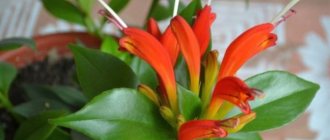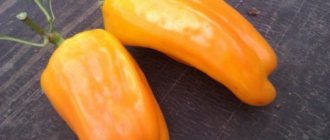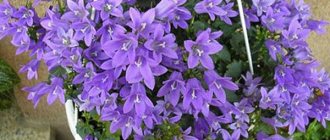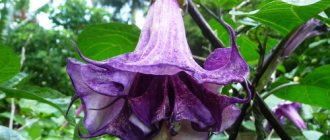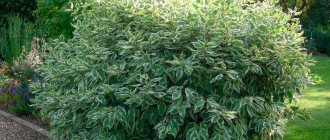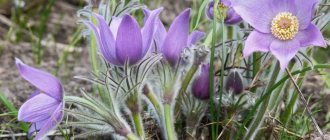2.Description - what it looks like
It is unlikely that a lumbago, a dream - grass or pulsatilla - this delicate fluffy bush will leave anyone indifferent.
Flowering bulbous perennials are small herbaceous plants with richly hairy, plush, green, deeply cut leaves The leaves are collected in basal rosettes and often form after flowering. The leaf blades are located on long pubescent petioles.
In early spring - immediately after the snow cover melts - the grass or snow tulip forms stocky, vertical peduncles .
Each peduncle bears an attractive goblet or bell-shaped flower , reminiscent of a tulip with fluffy petals. The flowers reach 8 cm in diameter and often remain half-open, consisting of 6 oblong petals.
The colors are varied and include white, yellow, lilac, burgundy, blue and purple. There are even almost black buds. In the center of the flowers there are bright yellow or orange stamens.
Even the seeds of the lumbago are fluffy - collected into a fruit - a multi-nut. The seeds are equipped with fluffy tails, which help the planting material to spread independently through the air with blowing winds.
The root system is powerful and lies at an impressive depth - it allows the flower to obtain food and water. A thick taproot extends into the soil vertically or at an angle.
↑ Up,
Currently, decorative lumbago is included in the genus anemone or anemone, but the flower differs in appearance and requires special care, so it is worth talking about it separately.
Height . Depending on the specific species, plants can reach 5–40 cm in height, and they often gain it gradually. In early spring, low flower stalks with fluffy flowers appear and then the bushes grow tall and form leaves.
↑ Up,
Growing and care
Due to the fact that lumbago grass is listed in the Red Book of Russia as an endangered rare species, its collection in wild places is strictly prohibited. In order to obtain a medicinal plant without breaking the law, people plant dream plants in their own garden plots. This is also facilitated by the decorative qualities of the lumbago.
Sleeping grass takes root well on sandy soils and actively reproduces by seeds, quickly spreading throughout the free area. The most preferable place for planting the dream plant is fertile fertilized land with high-quality drainage. Suitable fertilizers and lime can be applied. The plant does not like excess moisture, so low areas should be avoided in places where grass grows. Water the lumbago as needed, focusing on the condition of the ground. Water is added sparingly, avoiding overflow.
It is not recommended to replant flowers, since the survival rate after replanting is extremely low. If replanting cannot be avoided, then you need to dig up the entire plant with a large lump of turf.
When breeding lumbago, you should remember their toxicity and take precautions:
- limit access to the plant for children and pets, explain to older children what dream grass looks like and why they should not touch it;
- touch the stem, leaves and flowers only with gloves;
- If juice gets on exposed skin or mucous membranes, rinse the affected areas with plenty of running water.
After drying the sleep herb, the toxic properties disappear and the plant becomes relatively safe. However, it cannot be dried indoors, since toxic esters will continue to evaporate throughout the drying period. Having collected the parts of the dream book, it should be washed well and left to dry on paper or newspaper under a canopy in the shade. Dry material is suitable for use and recycling no earlier than after 3 months. This time will be enough for all toxic substances to evaporate.
3. Varieties and types:
3.1.Spread open, broad-leaved or dream - grass - Pulsatilla patens
The height of this primrose varies from 10 to 10 cm, flowering occurs in March - April. The first buds - bells - decorate the bushes even when there is snow in some places. The flower easily propagates by self-sowing.
↑ Up,
3.2. Meadow or blackening lumbago - PulsatiIIa pratensis
Perennial plants of this variety are often used in homeopathy. The bushes reach a height of 8 - 30 cm and have fluffy, thinly cut leaf blades. The buds are drooping, dark burgundy, bloom in early spring.
↑ Up,
3.3.Common lumbago - Pulsatilla vulgaris
Small wild-growing perennials 20-30 cm high. During the flowering period - in April - May, the bushes form attractive fluffy flowers of lilac or pinkish color with a yellow center.
↑ Up,
3.4.Red lumbago - Pulsatilla rubra
A fairly large variety, the bushes of which reach a height of 45 cm. The plants are distinguished by drooping flowers with reddish or burgundy petals that look like anemones. The flowers reach 6–8 cm in diameter
↑ Up,
3.5.Spring lumbago - Pulsatilla vernalis
One of the most delicate and early-blooming perennial species of lumbago, the bushes reach a height of only 8 - 10 cm. In the first warm spring days, the plants form fluffy flower stalks with pinkish, light yellow or white flowers. Frequency buds remain half-open. After flowering, leaves form.
↑ Up,
3.6. Large or large lumbago - Pulsatilla grandis
Early flowering perennials, common in eastern Europe. The bushes reach a height of 30 cm and during the flowering period they decorate themselves with blue or purple fluffy buds.
↑ Up,
3.7. Yellowing lumbago - Pulsatilla flavescens
Perennial herbaceous plants, the flowering of which occurs after the snow melts - in April - May. The first to appear are short flower stalks with fluffy, light yellow buds at the top, and then the leaf plates are formed.
↑ Up,
3.8.Turchaninov's lumbago - Pulsatilla turczaninovii
The variety is named after the famous Russian botanist. It is a bush from 5 to 35 cm high with tall peduncles with pinkish or purple buds at the top. The leaves are repeatedly dissected and form simultaneously with the flowers. With age, it grows and forms large grassy hummocks.
↑ Up,
3.9. Drooping lumbago - Pulsatilla cernua
The species is found in the foothills of Japan and northern China. Plants up to 20 cm tall have drooping, bell-shaped, richly pubescent burgundy buds. The flowering period occurs in April - May.
↑ Up,
3.10.Golden lumbago - Pulsatilla aurea
Most of all, these plants resemble buttercups. One of the latest blooming species, golden yellow buds appear in late spring and until mid-summer. Simultaneously with the buds or even earlier, leaves and stems are formed.
↑ Up,
3.11. Haller's lumbago - Pulsatilla halleri
Plants up to 15 - 20 m in height with early flowering. The first thing that appears from the soil is short, strong flower stalks with single, often drooping, large flowers of a lilac or lavender hue. The buds reach 8 cm in diameter. After flowering, the first leaves appear.
↑ Up,
3.11.1. Crimean lumbago - Pulsatilla taurica
One of the subtypes of Haller's shot. Miniature, richly hairy, early flowering perennials. The bushes reach a height of 20 - 30 cm. The leaf blades are green, covered with white pubescence, dissected into numerous thin segments.
↑ Up,
3.12. Alpine lumbago - Pulsatilla alpina
Highland perennials, common in Spain, Croatia and other countries of central and southern Europe. Unfortunately, this variety rarely takes root in garden plots. The leaves are repeatedly dissected, green, glossy. Peduncles with slight pubescence. The flowers are wide-open, white, pinkish, with a yellow or orange center, reminiscent of an anemone.
↑ Up,
3.13. Doubtful lumbago - Pulsatilla ambiqua
Compact plants up to 20 cm high with erect, thick, richly pubescent peduncles. The flowers are solitary, covered with dense light pubescence, with oblong burgundy, red, blue or purple petals. Flowering occurs simultaneously with the formation of leaf blades.
↑ Up,
3.14.Mountain lumbago - Pulsatilla montana
Another plant that prefers high rocky slopes is found in alpine meadows and is characterized by short, dense peduncles, half-open purple flowers with an orange center. The height of the plants is about 20 cm.
↑ Up,
3.15. Bunge's lumbago - Pulsatilla bungeana
The height of the bushes varies from 12 to 18 cm. The flowers are long, drooping, bell-shaped, light blue or dark blue, and are formed simultaneously with lacy green leaves.
↑ Up,
4.Planting and care in open ground
In order to get flowering bushes in early spring, it is worth working hard and providing optimal shooting conditions.
Planting in open ground is carried out after flowering - in May - June. You should not plant a flower in places where groundwater is shallow or in flooded lowlands - the bushes may rot. You should not select an area protected from the wind - the lumbago can withstand even fairly strong gusts and receive minimal damage due to its miniature size.
The flower is immediately given a permanent place - over time it will tolerate transplants more and more poorly.
↑ Up,
4.1.How and when to plant a lumbago
To carry out replanting, it is worth choosing cloudy and fairly cool weather - in the sun the plants will take root worse and will take longer to survive.
The area for planting a flower is dug up using a spade and the soil is leveled. Weeds are also removed. If seedlings grown in small pots are planted, they try to move the seedlings into the holes, minimally destroying the root ball - along with the soil. Lumbago reacts negatively to transplantation and should be done with minimal disturbance to the flower.
↑ Up,
If the bushes were grown in a common container, then it will not be possible to avoid the destruction of the earthen clod. Such plants are planted in deep planting holes, carefully straightening the long roots and making sure that they are not bent or directed upwards.
Sleep - the grass along the perimeter is sprinkled with earth, which is then lightly compacted and the plantings are watered with plenty of water. The bases of the bushes are mulched with a small layer of straw or mown grass - mulch will prevent moisture from evaporating too quickly and will retard the development of weeds.
↑ Up,
4.2.Light
Lumbago is tolerable in different growing conditions - it can be planted in partial shade, then flowering will occur a little later, but will last longer. If you choose an area open to the sun for cultivation, from which the snow melts early, then you will be able to see the buds of the lumbago as early as March, but the flowering will not last long.
↑ Up,
4.3.Soil
Lumbago loves soils with an alkaline pH level, so in a garden with acidic soil, it is worth adjusting the acidity. In order to obtain an alkaline or neutral soil, crushed chalk is mixed into it, watered with lime milk and dolomite flour is added.
↑ Up,
In order for plants to bloom profusely over a long period of time, they require a sufficient amount of nutrients - when planting in the ground, both organic fertilizers in the form of compost, well-rotted manure, and mineral fertilizers for flowering plants are mixed. The nutrient layer can be placed directly into the planting holes.
In soil that is too heavy and clayey, it makes sense to add a sufficient amount of river sand.
↑ Up,
4.4.How to transplant a lumbago
Only young plants can be replanted, and only as a last resort. The flower does not like replanting and if the plants are more than 10 years old, then after replanting they may even die. If necessary, the bushes are dug up and moved to a new place along with a lump of earth, trying to minimize the disturbance of the root system.
↑ Up,
4.5.Care in open ground, pruning
During the first month after planting, you should pay attention to timely watering - drying out the soil at this time can easily lead to the death of the flower. Well-rooted flowers in a new place will need watering only with the onset of hot and sufficiently dry weather - the rest of the time, the lumbago will withstand a slight drought quite well.
In the first year after planting in open ground or when growing seedlings, plants should be provided with shelter. Before the onset of frost, the bases of the bushes are covered with a high layer of soil and the green part is covered with pine or spruce branches on top, and in its absence - with dry fallen leaves.
↑ Up,
Adult bushes overwinter in open ground without any problems and will need additional shelter only in regions with little snow and too severe winters.
To maintain an attractive appearance, as soon as the snow melts, it is worth trimming last year’s dry leaves of plants at the base.
↑ Up,
4.6.Feeding
For abundant and long-lasting flowering, it is important to provide the lumbago with a sufficient amount of nutrients. These plants respond very well to the use of organic matter - sleep - the grass will gratefully respond to the addition of a nutrient layer of rotted manure or humus to the bottom of the planting holes. It is also good to mulch the flower with leaf litter or humus from time to time.
↑ Up,
In addition to organic matter, plants will also need mineral compounds, but they must be used wisely. Nitrogen fertilizers are not suitable for lumbago - when they are used, the plants will grow leaves abundantly and form too few buds. Potassium-phosphorus fertilizers are used as top dressing and applied monthly. To ensure that the chemical solution does not damage the root system of the flower, it is introduced into moist soil after abundant watering.
↑ Up,
5.Reproduction
5.1.Growing from seeds
For seed propagation, planting material collected with your own hands from plants planted in the garden is quite suitable. It is worth remembering that varietal plants with this method of propagation often do not correspond to the characteristics of the parent bushes and can differ strikingly from them.
Germination varies among different species, but usually it remains at a high level for 2 - 3 years after collection.
Some varieties are sterile and do not produce seeds even if pollinated.
↑ Up,
After flowering, you should wait for the fluffy heads with seeds to form and cover them with gauze in a timely manner so that the seeds do not fly away with gusts of wind. Planting material matures 4 - 5 weeks after flowering. After complete ripening, the seed heads are separated from the lumbago bushes and the seeds are selected, which are then dried in a warm and well-ventilated place. After drying, the planting material is stored, poured into fabric or paper bags.
Planting in seedling boxes is carried out in early spring - in March. A drainage layer in the form of expanded clay, clay shards or brick fragments is placed at the bottom of the boxes or individual pots. Fill the containers with a slightly moist, nutritious and loose substrate, mixed in equal parts with river sand.
↑ Up,
Plain varieties can be sprinkled with a small layer of soil on top. Seeds of high-mountain species of sleep-grass require preliminary cool stratification and light to germinate; they should not be covered with soil on top - simply pressing them into the soil surface is sufficient.
Mountain lumbago is difficult to grow in garden plots, so it is advisable to choose plants that live at low altitudes above sea level.
The main difficulty when growing lumbago from seeds is maintaining high air temperatures. In order for the seeds to germinate successfully, it should be 25 - 27 degrees.
↑ Up,
The seedlings are covered with plastic film or a transparent plastic cover on top to create a greenhouse effect and maintain high air humidity.
If you follow the rules of agricultural technology, the first shoots can be noticed within 1 - 2 weeks. Sometimes seed husks remain on the tops of small plants - they are sprayed with water daily and sometimes carefully removed with tweezers.
The plants are ventilated daily by removing the cap and increasing the ventilation time.
↑ Up,
With the formation of 2 - 3 true plates, you can plant flowers grown in a seedling box into separate cups. Of course, it is advisable to transfer the flowers along with the root ball. Another 7 - 10 days after the dive, you can first feed the bush with a weak solution of nitrogen fertilizers.
Dream seedlings are planted in open ground - herbs are planted in the summer - in July or in the first half of August.
You can sow seeds directly into open ground. It is best to do this in the spring, when the threat of the last night frosts has passed - for example in May.
↑ Up,
For bushes growing high in the mountains in their natural habitat, it is better to arrange winter sowing - with this method of growing, the plants will undergo natural cool stratification. These varieties include alpine, mountain lumbago and Tatewaki.
For sowing, prepare small furrows about 1 cm deep, maintaining a distance of about 10 cm between them. After sowing, the soil is thoroughly moistened and kept constantly moist, but not waterlogged.
For seed propagation, the gardener should be patient, because the first buds will decorate plants grown from seeds at least in the second year of development, and for some varieties this period can increase to 7 years.
↑ Up,
5.2. Division of the lumbago
Unfortunately, the lumbago does not like even simple transplants, and most likely will not tolerate division at all. The fact is that the flower has a taproot and damage to it will cause the death of the plants.
6. Useful properties
Despite the fact that the flower has many beneficial properties, it should not be used uncontrollably - the plants are poisonous and contain toxins. In order to get rid of them, the green mass of the lumbago is dried in a hanging state or spread out in a small layer in a warm and ventilated room without access to the sun and then stored open. Such raw materials can be consumed only 3 to 6 months after collection.
It is better to collect during the flowering period - it is at this time that the maximum concentration of useful substances in the composition is achieved.
Bushes are used in folk medicine as an analgesic, sedative and sleep quality improver (analogous to antidepressants). It is believed that the flower also has antimicrobial properties and can have an enveloping effect in diseases of the digestive tract. For diseases of the upper respiratory tract, the herb is used as an expectorant. The plant relieves pain well and alleviates the condition of people suffering from rheumatism. For skin diseases - eczema or scabies, prepare an infusion of lumbago and wipe the affected skin with it.
Drops containing lumbago extract are used to prevent eye diseases such as glaucoma and cataracts, and also as a sedative.
Lumbago has also found its use in homeopathy.
Contraindications to the use of medicines based on this primrose are all kinds of allergic reactions and individual intolerance, pregnancy and breastfeeding, acute inflammatory processes in the body.
↑ Up,
Features of an open lumbago
In what regions can you find lumbago? Is harvesting grass allowed? What are the main indications and contraindications for use?
Habitat
Open lumbago, or sleep-grass, is found in Europe, especially in the middle zone and southern regions. But it can also be seen in Northern Europe - Sweden and Finland. It also grows in Siberia, Kazakhstan, Mongolia, China, the Far East, and North America. Loves dry pine and mixed forests, open meadows and forest edges, sunny slopes, meadows and steppes.
Botanical characteristics
- Perennial herbaceous plant.
- The stem is erect, covered with thick soft hairs.
- At the end of the stem there is a large bell-shaped flower of light purple color.
- The flower has numerous yellow anthers (the upper part of the stamen).
- The leaves are silvery, heavily pubescent, dissected.
- Blooms in March-May depending on the area.
- Reproduces only by seeds.
Is it possible to collect grass
The grass is listed in the Red Book of Russia. In particular, collecting the plant is prohibited in the Moscow, Ryazan, Lipetsk, Oryol, Tula, and Kaluga regions. In some regions, lumbago is becoming a rare plant. Belongs to a declining, vulnerable species. For example, at the end of the 19th century there were sixteen populations of the flower, today there are only nine. What is the reason for grass dying out? Collection for bouquets, mass procurement as medicinal raw materials, overgrowing of plant habitats with dense grass.
You can grow sleep grass in your garden both as a beautiful decorative flower and as a medicinal raw material. The entire aerial part is used for medicinal purposes. Experienced herbalists do not recommend preparing any home remedies from fresh herbs. Fresh stems, leaves and flowers contain protoanemonin, a toxic substance. During drying, after about 3–4 months, it evaporates. But the raw materials do not lose their medicinal properties and become less toxic.
Healing effect
Medicinal properties of sleep herb:
- pain reliever;
- astringent;
- sedative;
- relaxing;
- hypnotic;
- anti-inflammatory;
- bactericidal;
- diuretic;
- choleretic;
- expectorant;
- enveloping;
- wound healing.
Chemical composition:
- saponins;
- coumarins;
- volatile substances (anemonin);
- camphor;
- tannins.
List of indications
What does sleep herb help with? For what diagnoses is it recommended to take the herb?
- Functional disorders of the nervous system. Main indications: migraine, agitation, insomnia, irritability, hysteria, headache. The herb also improves emotional well-being, improves mood, and relieves attacks of melancholy and depression.
- Respiratory system. An open lumbago gives an antispasmodic and expectorant effect. It is prescribed for coughs (bronchitis, bronchial asthma, whooping cough).
- Benefits for women's health. The herb has a pronounced sedative effect and helps to calmly survive the premenopausal period. Relieves symptoms of PMS. It especially helps with spastic pain in the lower abdomen, headaches, unstable emotional state, tearfulness, and irritability. Ancient herbalists describe that lumbago was previously given to women to stimulate labor and also relieve pain.
- The cardiovascular system. It is less often mentioned that the plant lumbago is beneficial for cardiac disorders, stimulates cardiac activity, relieves vascular spasms, and lowers blood pressure.
- External use. You can use rubs for joint diseases (rheumatism, gout, arthritis), treat wounds, eczema, fungal skin infections, and burns with strong infusions. The herb acts as an anesthetic and antiseptic.
Some sources indicate that lumbago herb helps with cataracts and glaucoma caused by increased intraocular pressure. There is also information that the plant has antitumor properties and helps with cancer. It is also taken for benign prostate tumors in men.
What are the contraindications for lumbago? It is forbidden to take it for inflammation of the gastrointestinal tract and kidneys, for pregnant women (may cause miscarriage), and for children. Fresh grass can cause severe allergies and burns upon contact with skin and mucous membranes. In case of overdose and long-term use, anemonine poisoning is possible, as well as disorders of the nervous and digestive systems. You should not take the medicine without consulting a doctor.
7.When lumbago blooms
Depending on the variety, flowering can occur at different times - from the very first days of spring, as soon as the ground surface thaws, until the last days of May. The flowering period is quite long - it can last 2 - 3 weeks. Due to the early flowering period, lumbago is sometimes popularly called snowdrop, although these plants have little in common.
↑ Up,
Dream grass in everyday life
Previously, artists used the juice of the grass to dilute paints. It was believed that paint diluted with lumbago juice lasts longer on the canvas and does not fade or fade.
In veterinary medicine, in many Asian countries it is still used - the herb is used to cure an animal of glanders. In addition, small livestock consume this plant for food in the spring. At the beginning of summer, shepherds watch their livestock vigilantly; with the onset of summer, the plant becomes poisonous and cannot be eaten.
9.Use in landscape design
The shot looks great in rock gardens and alpine slides. Both single and group plantings are effective, with a combination of different shades of buds and plants with different timing of flowering. Other primroses, such as orange crocuses and bright tulips and daffodils, beautifully set off the lumbago bushes.
↑ Up,
Dream grass in mythology
Since ancient times, mystical stories have surrounded lumbago grass. The flower acquired its second name thanks to a legend. The legend said that due to its beauty, the purple bell was very attractive to evil spirits. With the help of an unusually bright flower, evil spirits befuddled people's consciousness, pushing people to sin.
The balance of Good and Evil was upset, God's Angels were forced to intervene. The Elder Archangel threw his spear from heaven to earth, after which the middle of the flower flashed orange. Since then, all evil spirits have been afraid of the flower like fire, and people began to call the dream grass arrow grass or lumbago.
In Slavic mythology, dream grass was often used to see a prophetic dream. It was enough just to put a bunch of grass at the head of the bed.
Among the people, the dream grass has acquired several nicknames: dream grass, sonchik, samsonchik. People still use its sleeping pills to this day.
